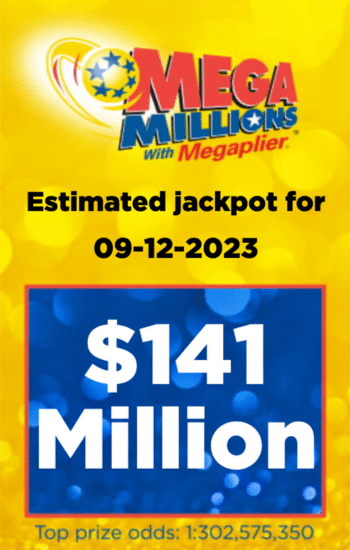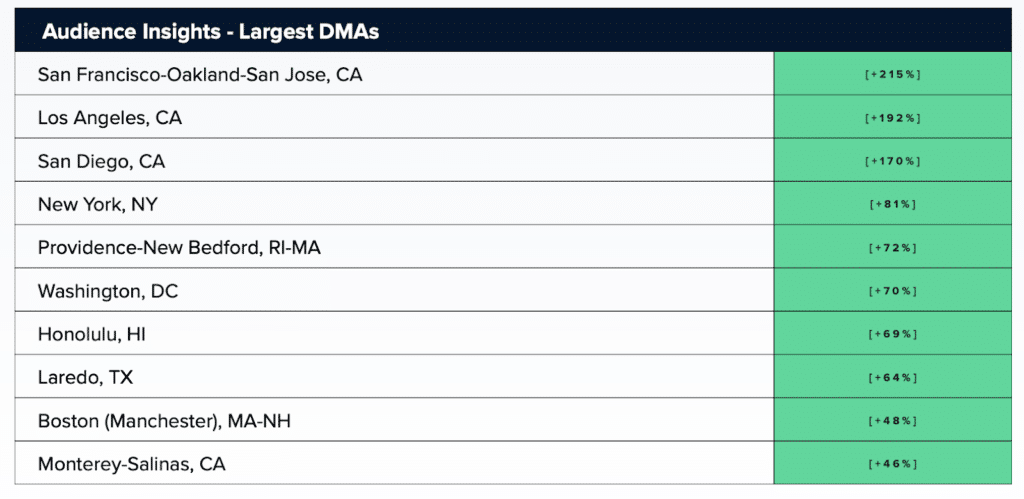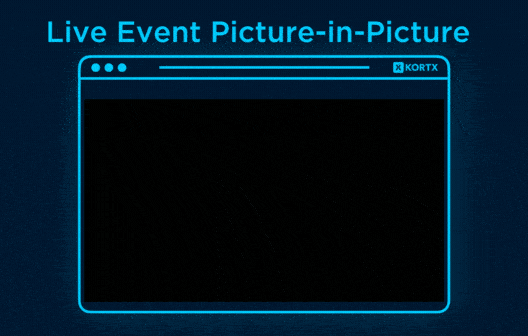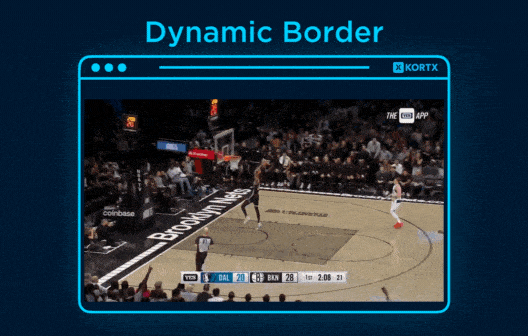Lottery marketing strategies have evolved far beyond traditional methods like linear TV ads to grab ticket buyers’ attention.
Lottery advertisers now have access to instant, dynamic jackpot updates in ad creatives, sophisticated website tagging, and targeted digital campaigns, making reaching as many potential players as possible easier than ever.
Join us as we review the top 6 lottery marketing strategies of 2023, offering our expert insights into what is reshaping the lottery this year.
1. Using RSS Feeds to Show Live Jackpots on Ad Creatives
Integrating RSS feeds into ad creatives means the ad’s visuals and messages can change dynamically, based on real-time data, without manual human intervention. As jackpot amounts fluctuate, so does the advertisement’s creative content, displaying the most current and enticing figures to potential players.

An example of a dynamic custom trigger ad. As the lottery jackpot rises, the ad automatically updates via RSS feed to reflect the new amount.
Gone are the days of manually changing jackpot information on ad creatives. Dynamic trigger ads auto-update from an RSS (Really Simple Syndication) feed. The feed pulls the latest info and displays it on the ad, without wasting any time manually changing out the ad creative.
Seeing the new jackpot amount can inspire more purchases as lottery ticket sales double every few days when jackpots swell.
2. Setting Up Custom Triggers To Maximize Advertising Budgets
Custom event trigger ads, like dynamic ad creative triggers, can efficiently initiate lottery ads based on specific criteria, such as reaching a specific jackpot amount.
For example, an ad campaign can be programmed to launch automatically when the jackpot reaches a predetermined threshold.
Consider these examples:
Triggered at $325 million
Triggered at $425 million
By focusing your marketing during peak jackpot times, you increase the chances of success. This method enables flexible budgeting, allowing you to adjust spending based on jackpot size or budget limits. Each lottery game can stay within budget, with spending targeted on the most effective advertising.
Custom trigger lottery ads offer unprecedented control over how, when, and where the lottery ads appear. Marketers can fine-tune their strategies for each lottery, optimizing the campaign based on individual performance and audience preferences.
📚 Related Article: Dynamic Lottery Ads: The Incredible Power of Custom Triggers: Discover how custom triggers can help you maximize your lottery advertising budget.
3. Utilizing Site Tagging and Attribution Data to Inform Future Campaigns
Analyzing player interactions across different marketing channels allows lottery marketers to identify key patterns and trends. One way lottery marketers can do this is through site tagging.
▶️ Site tagging involves embedding specific tags or tracking codes on a website. These tags collect data on user behavior, such as clicks, page views, and conversions. It can help you understand how users interact with your site and what drives them to action.
▶️ Site attribution focuses on identifying the traffic sources and determining which marketing channels or campaigns contribute most to your goals, whether user engagement, sign-ups, or revenue generation. It helps in understanding the overall contribution of your website in the marketing funnel.
Understanding which channels yield the best outcomes means you’re set up for successful future campaigns.
4. Reaching All Counties in a State
Typically, lottery advertising media budgets go to the most populated areas in a state. Although this allows for extensive coverage, focusing solely on high-population areas might neglect potential players in less-populated regions.
We helped one of our state lottery clients implement a plan to deliver their marketing content and budget evenly across all zip codes.
Using our proprietary tool, Axon Audience Manager, which supplements a client’s First-Party data with rich, Third-Party data sources, we can provide a deeper audience understanding.
What’s one strategy we’ve successfully used with our lottery clients?
“A successful strategy we’ve implemented with our lottery clients revolves around ensuring comprehensive statewide reach. Our client’s focus had been on achieving equitable media distribution across all counties, not just targeting the most populated areas.
To accomplish this, we’ve configured their advertising campaigns to distribute their budget uniformly across all zip codes in the state. Every region, regardless of its population density, receives equal exposure to lottery promotions, expanding reach like they’d never seen before.”
We offer the capability to build custom, First-Party lottery audiences, crafting distinct audience profiles for each county or zip code using thousands of segmentation options. Then, we can spread the budget to all zip codes across the state.
This way, residents in every county, regardless of size or population density, receive equal exposure to lottery games and promotions.

📍 Reach Lottery Buyers In Every State County
With Axon Audience Manager, our team can ensure that everyone in the state sees your ads, not just the largest cities.
5. Leveraging Programmatic Digital-Out-Of-Home and Seasonal Trends
During the holiday season, people are more likely to frequent bars, making it an ideal time to engage potential Keno players using programmatic Digital-Out-Of-Home (pDOOH).
pDOOH uses automated buying, selling, and ad delivery in programmatic advertising to advertise on out-of-home platforms like digital billboards and signage.
What’s one strategy we’ve successfully used with our lottery clients?
“For one lottery client, we’ve adopted a focused strategy for Keno, targeting players in bars during the busy holiday season in Q4. This taps into the higher foot traffic and festive mood in these venues, creating an ideal opportunity to engage Keno players and maximize the impact of our campaigns.”
pDOOH screens at gas stations can capture lottery players’ attention while refueling. Other options include convenience stores, digital billboards on freeways showcasing jackpot amounts, public transit hubs, and other high-traffic areas.

An example of a dynamic digital billboard.
We can also combine the power of pDOOH with custom triggers. When jackpot values change, the amounts displayed on these billboards can be updated in real-time using custom triggers, drawing attention and encouraging ticket purchases.
📚 Related Article: Programmatic DOOH: What It Is, Benefits & Examples: Learn more about how to reach your audience on the go, wherever they are.
6. Targeting Sports Viewers with Picture-in-Picture and Trigger-Based CTV Ads
Many lotteries worry that sports betting may take away from lottery sales. With programmatic CTV advertising, we can specifically target audiences who watch sports (NCAA, motocross, etc) with lottery ads, including those with custom trigger capabilities.
Using CTV ad types like Picture-in-Picture, lotteries can present ads alongside live events, maintaining engagement without distraction.

An example of live event Picture-in-Picture interactive CTV advertising.
We can also set up ads to trigger based on specific critical in-game events, like slam dunks in basketball or a golf ball landing in the water.
An example of a trigger set up to display the ad after an in-game event, like a slam dunk.
Capitalizing on high-adrenaline moments like the final laps in motocross can heighten viewers’ emotions, hopefully inspiring additional lottery ticket sales.
📚 Related Article: Interactive CTV Ads are the Secret to Higher Engagement and Longer Viewing Rates: Learn more about how these captivating ads can reach your audience during a game’s critical moments.
Supercharge Your Lottery Strategy
In the fast-evolving world of lottery advertising, traditional methods like linear TV ads are no longer sufficient to capture players’ attention. Our review of the top 6 lottery marketing strategies highlights a pivotal shift in the industry, embracing the digital age and focusing on precision targeting, relevance, and timeliness as key drivers to boost sales.
From utilizing RSS feeds for live jackpot updates to using advanced site tagging, these expert lottery marketing strategies aim to elevate your strategy in the years to come.
See Your Jackpot Soar! 🚀
Our expert team has decades of experience helping lottery clients craft campaigns that reach unprecedented heights.
Let us help you.
About the Author
Maria Barnd is a Senior Account Manager at KORTX.



